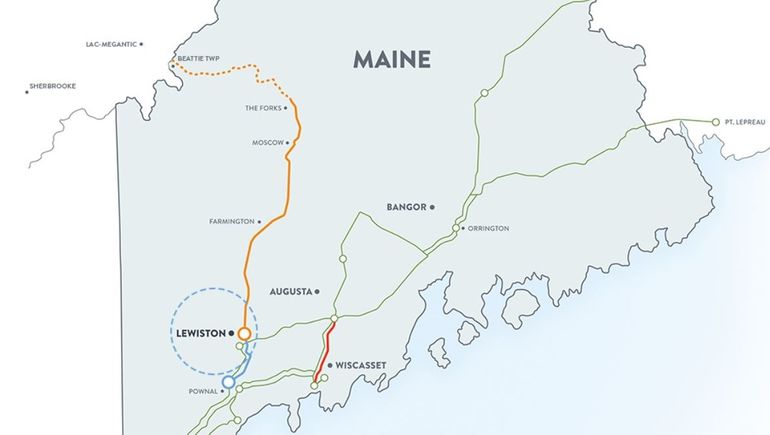Full construction can start on NECEC transmission line as injunction is lifted
 Courtesy / Central Maine Power
The orange line shows the NECEC transmission line corridor from the Canada border to Lewiston. The dotted portion is Segment 1, which was under an injunction that was lifted Thursday, allowing work there to begin.
Courtesy / Central Maine Power
The orange line shows the NECEC transmission line corridor from the Canada border to Lewiston. The dotted portion is Segment 1, which was under an injunction that was lifted Thursday, allowing work there to begin.
An injunction that prevented work on a northern stretch of the New England Clean Energy Connect transmission line was lifted Thursday afternoon, meaning a Central Maine Power Co. affiliate building the line can begin full construction.
The U.S. Court of Appeals in Boston vacated a January injunction on work on the Segment 1 portion of the project, ruling that the plaintiffs "have failed to show a likelihood of success on the merits" of their complaint that the U.S. Army Corps of Engineers issued a permit for the project without a a full environmental assessment.
The ruling is "a victory for Maine's clean energy future," said Thorn Dickenson, president and CEO of NECEC Transmission, the company building the 145-mile line that runs from the Canada border through Somerset, Franklin and Androscoggin counties to Lewiston.
The news comes as the AFL-CIO, which represents 36,000 trades workers in Maine, endorsed the project, citing the 1,600 jobs the project is expected to generate.
The fact the injunction is vacated means that NECEC Transmission can begin work on Segment 1, the 53-mile stretch from the Forks, in Somerset County, to Beattie Township, on the border with Canada in Franklin County. The company in February started work on the 92 miles that are on an existing transmission corridor that between The Forks and Lewiston. The line is being built on land owned or controlled by CMP, which transferred ownership of the line to NECEC in January. Both are under parent company Avangrid (NYSE: AGR).
The Sierra Club, Appalachian Mountain Club and Natural Resources Council of Maine in October sued the Corps of Engineers and Central Maine Power in an attempt to stop construction. They and other opponents say the work will damage Maine's natural environment and have a negative impact on wildlife habitat.
NECEC said the line is being built in working forests that will be cleared using a tapered vegetation technique, which preserves more forest canopy and wildlife habitat than typical transmission corridors. Before state Department of Environmental Protection approval in March 2020, developers of the line made a number of environmental concessions, including cutting the width of the lines from 150 feet to 54 feet, preserving wildlife habitat, lessening effects on the Kennebec River and more.
No CMP Corridor, the major group in opposition to the project, said in a prepared statement it is disappointed in the court decision and that the injunction "has protected the most remote and environmentally sensitive segment of CMP's proposed corridor from development."
"We have watched the destruction CMP has hastily inflicted ahead of the November vote with horror," said spokesperson Sandra Howard. "Simply put, the clear cutting and environmental damage that is occurring, and can now occur in Segment 1, is devastating." The statement cited a case in Maine Superior Court that is considering whether CMP's lease of public land in Segment 1 will alter the land's use. If it is found to, it means the Legislature has to approve the project by a two-thirds vote.
Given that, and a citizens' initiative referendum on the November ballot seeking to halt the project, "CMP should not be allowed to clear a single twig from these lands until the issue is resolved," the statement said.
A similar ballot measure, that sought to overrule the Public Utilities Commission's approval of the project, was thrown out by the Maine Supreme Judicial Court last year, which ruled that citizens initiatives can't overturn regulatory authority. The new referendum seeks to ban construction on Segment 1 and require a two-thirds vote of the Legislature for any such projects.
"The NECEC has met every benchmark in a rigorous, three-year permitting process, resulting in $300 million in contracts to Maine construction companies and nearly 80% of jobs going to Maine workers," Dickinson said Thursday.
Endorsed by AFL-CIO
The project Thursday was endorsed by the executive board of the Maine AFL-CIO. “This will put several hundred Maine union members to work building the electrical infrastructure we need for a clean energy future.” said Cynthia Phinney, president of the Maine AFL-CIO.
The labor organization said that members of International Brotherhood of Electrical Workers Local 104, Laborers’ International Union of North America Local 327 and International Union of Operating Engineers Local 4 are already working on the project doing tree clearing, right-of-way building, specialty pole foundations and matting and installing environmental protections and controls.
IBEW 104 members will begin constructing the line later this month, Tim Burgess, IBEW 104 assistant business manager said.
“Building electrical infrastructure is what we do and we are proud to be working on the NECEC project and to help reach the renewable energy goals recently set by our president and the governor,” Burgess said. “Many of our members often find themselves traveling to other states in New England, or even further to other regions of the country to work on these types of Infrastructure projects, which enhance the stability and reliability of our nation’s electric grid.
"Our future electrical energy needs will require a large mix of generation sources, and transmission methods — projects such as the NECEC are a small but necessary piece of a larger puzzle. The construction of the NECEC project is a welcomed opportunity for our members to showcase their construction skills here at home, where they are consumers, voters and taxpayers," he said.
The NECEC is giving preference to Maine workers, including a mix of union and nonunion labor, paying an average salary of $38 an hour and other benefits, according to the developers. More than 70% of the IBEW 104’s available worker-hours are dedicated to the project, and that's expected to increase as the work on the NECEC accelerates, the AFL-CIO said.
NECEC is looking to hire line workers, apprentices seeking on-the-job-training, equipment operators, ground workers, heavy equipment operators and ground cutters.
Construction-related businesses in Maine have made some shifts to position themselves for project. Saco-Based Sargent Electric in November leased a 13,000-square-foot warehouse at 45 Alfred Plourde Drive in Lewiston to prepare for the line work.
"They wanted to be in Lewiston," Nick Lucas, of Boulos Co., told Mainebiz in January. "It's accessible to a lot of their business" related to the transmission line.
NECEC has said the project will generate $18 million a year in host community tax revenue and increase the state's gross domestic product by $573 million.
Once completed, it will deliver 1,200 megawatts of hydropower to the New England energy grid, connecting in Lewiston, and will be New England's largest source of renewable energy. The project is being paid for by Massachusetts electricity customers, part of that state's initiative to reduce carbon emissions.
Dickinson, of NECEC, said Thursday, "The Clean Energy Corridor will eliminate more than three million metric tons of dirty emission from the New England energy grid a year by replacing fossil fuels with clean hydropower, reducing pollution and improving air quality in Maine for generations to come.”














0 Comments